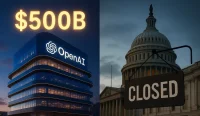Trump’s absence during the first day of a government shutdown represents an unprecedented political moment as the administration threatens imminent layoffs of federal workers while the president remains completely out of public view. As the shutdown enters its 19th hour with no end in sight, Trump’s conspicuous absence stands in stark contrast to his usual pattern of seizing the moment and dominating media coverage during major political events.
The president, who typically loves to be seen and heard during controversial moments, has not appeared in public, made statements, or even posted on social media beyond sharing AI-generated videos targeting Democrats. This unusual silence comes as his administration warns that layoffs are imminent, with Trump’s budget chief telling Republicans to expect pink slips within the next day or two.
Unlike previous government shutdowns where federal workers were furloughed with the expectation of back pay when the government reopened, the Trump administration is specifically using the term “layoffs” – permanent terminations that represent a fundamental break from established precedent. This escalation creates unprecedented uncertainty for hundreds of thousands of federal employees who face the prospect of permanent job loss.
Table of Contents
The Unprecedented Nature of Permanent Layoffs
During this crisis becomes even more significant given the administration’s threat to permanently lay off federal workers rather than implementing the traditional furlough system. This represents a fundamental departure from how government shutdowns have been handled throughout American history, creating a new level of uncertainty and fear among federal employees.
The traditional furlough system provided a safety net where workers were sent home without pay but with the guarantee of back pay once the government reopened. This system recognized that shutdowns were temporary political disputes that shouldn’t permanently damage workers’ livelihoods. The Trump administration’s shift to permanent layoffs eliminates this safety net and creates genuine economic hardship for affected workers.
The timing of these threatened layoffs is particularly cruel, coming as the country faces economic uncertainty with private sector job losses of more than 32,000 in September – the biggest number in over two years. The combination of private sector job losses and threatened federal layoffs creates a perfect storm of economic anxiety that affects workers across all sectors.
The administration’s decision to use the term “layoffs” rather than “furloughs” appears to be a deliberate escalation designed to increase pressure on Democrats to negotiate. However, this strategy risks backfiring by creating sympathy for federal workers and potentially damaging the Republican Party’s political standing, as evidenced by historical precedent where voters typically blame the party responsible for shutdowns.
Economic Data Blackout and Hidden Economic Deterioration
The government shutdown means that crucial economic statistics, including the official jobs report, will not be released, creating a dangerous information vacuum that could mask underlying economic problems.
The ADP report, released by a private company, provides the only available employment data and shows a grim picture: more than 32,000 jobs lost in September, with additional job losses in August. This contradicts Trump’s recent claims that “jobs are being created right now” and “a lot of jobs are coming in, you know, like I think we’ve never seen before.” The data reveals these statements to be fantasy rather than reality.
The Wall Street Journal’s analysis of Commerce Department data shows America’s gross output slowing to a crawl, with business spending at all stages of production declining. As the Journal notes, “when business puts on the brakes, employment slows and recession strikes.” This deeply worrisome economic data is landing at the same time the country faces an unprecedented shutdown with no clear resolution path.
The economic data blackout creates additional uncertainty for financial markets, businesses, and policymakers who rely on government statistics to make informed decisions. Without access to official economic data, it becomes much more difficult to assess the true health of the economy and respond appropriately to emerging challenges.
Political Polarization and the Breakdown of Governance
The political dynamic has shifted from traditional negotiations where lawmakers would “go into a room and hammer out a solution” to a binary choice between “fealty to Trump instead of the country or oppose Trump no matter what.” This polarization makes resolution extremely difficult because both sides view compromise as capitulation to their political enemies.
Democrats remain united in their demands for extending Obamacare subsidies and reversing Medicaid cuts, while Republicans appear confident in their position despite the potential political risks. The Republican strategy seems to be based on the assumption that the pain of layoffs will force Democrats to negotiate, but this approach risks creating a humanitarian crisis that could damage the party’s long-term political prospects.
The absence of traditional political leadership during this crisis is particularly concerning because it suggests that neither side is willing to take responsibility for resolving the situation. Trump’s decision to stay out of the public eye may reflect an understanding that his involvement could make resolution more difficult, but it also represents an abdication of presidential leadership during a national crisis.
The Role of Social Media and Political Theater
Trump’s absence from traditional media coverage doesn’t mean he’s completely silent, as evidenced by the AI-generated videos playing on loop in the White House press room. These videos, featuring Democrats with sombreros to suggest they want to give healthcare to illegal immigrants, represent a new form of political theater that prioritizes symbolism over substance.
The sombrero videos, which have no basis in actual Democratic policy proposals, serve as a distraction from the real issues at stake in the shutdown. They represent a continuation of Trump’s pattern of using inflammatory imagery and false narratives to rally his base while avoiding substantive policy discussions that might require compromise or nuanced thinking.
Vice President JD Vance’s defense of the sombrero videos, claiming he “doesn’t even know what that means” when called racist, reflects the administration’s strategy of normalizing offensive behavior while avoiding accountability. This approach may energize the base but does nothing to address the underlying issues that led to the shutdown.
The focus on political theater rather than substantive policy discussions makes resolution of the shutdown more difficult because it shifts attention away from the real issues and toward symbolic battles that have no bearing on the actual policy differences between the parties.
Beyond the Noise: Real Work Matters
As politics drifts into spectacle, it’s more important than ever to focus on meaningful work that drives real impact. Employers can cut through the noise by hiring professionals who value substance, accountability, and long-term results. Post your job on WhatJobs today and connect with candidates ready to deliver beyond the distractions of political theater.
Post a Job Free for 30 Days →The Human Cost of Political Gamesmanship
The threatened layoffs represent more than just political posturing – they represent real economic hardship for hundreds of thousands of American families. Unlike private sector layoffs that are typically based on economic necessity, these layoffs are purely political and serve no legitimate policy purpose beyond increasing pressure on the opposing party.
The lack of presidential leadership during this crisis means that there is no clear voice explaining to the American people why this shutdown is necessary or what the path forward might be. This vacuum of leadership creates uncertainty and anxiety that extends far beyond the federal workforce to affect the broader economy and public confidence.
The administration’s decision to threaten permanent layoffs rather than traditional furloughs represents a fundamental misunderstanding of the purpose of government shutdowns. These events should be temporary political disputes, not opportunities to permanently damage workers’ livelihoods or create lasting economic hardship.
Frequently Asked Questions
Why is Trump absent during the government shutdown?
Trump’s absence during the government shutdown may reflect a strategic decision to avoid being associated with the crisis, as his involvement could make resolution more difficult and potentially damage his political standing.
What makes this shutdown different from previous ones?
This shutdown is unprecedented because the administration is threatening permanent layoffs rather than traditional furloughs, and it occurs during extreme political polarization where compromise has become nearly impossible.
How do the threatened layoffs affect federal workers?
The threatened layoffs create permanent job loss rather than temporary furloughs, eliminating the safety net of back pay and creating genuine economic hardship for hundreds of thousands of federal employees and their families.
What are the economic implications of the shutdown?
The shutdown creates a data blackout that prevents accurate economic assessment, while threatened layoffs and existing private sector job losses create a perfect storm of economic uncertainty that could accelerate recessionary trends.
A Real-World Example: Sarah’s Federal Worker Dilemma
Sarah Chen, a 42-year-old Environmental Protection Agency analyst from Washington, D.C., represents the human cost of the government shutdown and threatened layoffs. After 15 years of federal service, Sarah faces the prospect of permanent job loss due to political gamesmanship that has nothing to do with her job performance or the value of her work.
“I’ve dedicated my career to protecting the environment and serving the American people,” Sarah explains. “Now I’m being told that my job might be permanently eliminated not because of budget constraints or performance issues, but because of a political dispute that I have no control over.”
Sarah’s situation is particularly difficult because she’s a single mother with two children in college. Unlike previous shutdowns where she knew she would eventually receive back pay, the threat of permanent layoffs creates genuine financial panic about how to pay her mortgage and support her family.
“The uncertainty is the worst part,” Sarah says. “I don’t know if I should start looking for a new job, if I should try to save money by cutting expenses, or if I should just wait and hope that this gets resolved. The administration isn’t giving us any clear guidance about what to expect.”
Sarah’s story illustrates how the political gamesmanship of the shutdown affects real people who are simply trying to do their jobs and serve their country. The threatened layoffs represent a betrayal of the social contract between the government and its employees, creating lasting damage to the federal workforce and the services they provide to the American people.
“The most frustrating part is that this has nothing to do with our work,” Sarah reflects. “We’re being used as pawns in a political game, and there’s nothing we can do about it. It’s not fair to us, and it’s not fair to the American people who depend on the services we provide.”
Sarah’s experience demonstrates that the government shutdown and threatened layoffs aren’t just political theater – they represent real economic hardship and uncertainty for hundreds of thousands of American families who are caught in the crossfire of political dysfunction.




